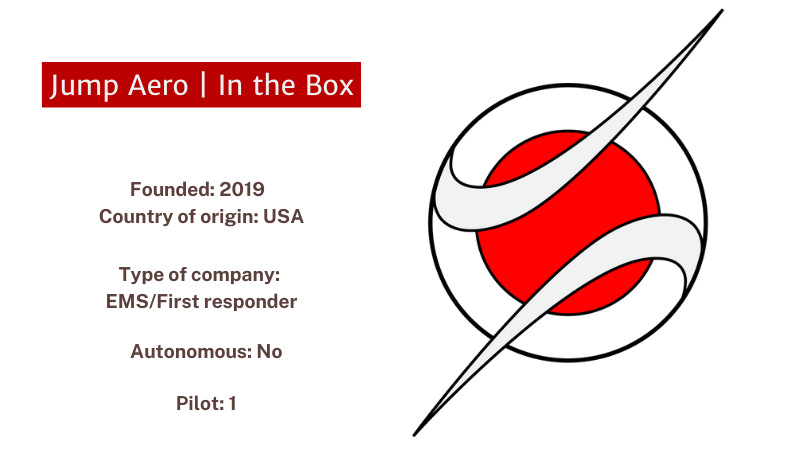Revolution.Aero Uplift: Getting the Jump (Aero) on first responder eVTOL services
You look up from the desk in your home office to see someone having a heart attack in their driveway across the street. You dial 911. The call is routed to either a private ambulance or public rescue service. They fire up their engines, drive through traffic and arrive on the scene an average eight to nine minutes later.
You look up from the desk in your home office to see someone having a heart attack in their driveway across the street. You dial 911. The call is routed to either a private ambulance or public rescue service. They fire up their engines, drive through traffic and arrive on the scene an average eight to nine minutes later.
Using eVTOLs, Jump Aero wants to do this in half the time. Katerina Barilov, head of business development for the start-up, is confident that introducing eVTOL technology to first responder services can significantly decrease response time.
Jump’s first vehicles will be designed to carry one paramedic, who will also be the pilot flying the aircraft. Single-seat aircraft are much easier to certify, fly and maintain, Barilov told Revolution.Aero. “We are uber focussed on getting to market as quickly as we can. And proving to the FAA that we can save lives.” The company hopes to see flying paramedics as early as 2025.
Investors:
Friends and family round: Completed
Seed round: 2021 (targetting institutional investors)
The team at Jump Aero brings years of aviation and entrepreneurship experience to the table – with Carl Dietrich, co-founder and President of Jump and formerly CEO and chief technology office of flying car company Terrafugia. Anna Dietrich, director at Jump and formerly chief financial officer of Terrafugia. Jeff Myjak, co-founder and head of production design and the founder of Stillwater Design. And Barilov, who has experience in aviation finance, as an MD at Shearwater Aero Capital and an investment banker at Goldman Sachs.
Also notable is its advisory board, which boasts a range of seasoned professionals.
Traditionally, EMS is typically a service-based model, where public agencies contract private ambulance services and drone operators for search and rescue missions. However, when Jump starts working with private partners – which Barilov says the company is doing at the moment – things could change.
“Our business model will depend on what would be most beneficial to our customers. Either way, we will be heavily involved after the point of sale or lease as we are going to be servicing and maintaining the aircraft for the agency,” she said.
Whatever the case, Jump aims to give its customers the best model based on their needs.
“In the healthcare industry, unlike the commercial travel, the margins are much higher. If you think about how much people pay for healthcare services, there’s a lot more room for flexibility from a business perspective.”
Last year was a difficult time for new entrants in any industry to raise investment, however Barilov says that Jump has just concluded an oversubscribed ‘Friends and Family’ funding round. She also told attendees at Revolution.Aero Global 2020 that the company is well on its way to securing customer contracts. It has eyes set on including some institutional investors in its seed round this year.
How can start-ups find early investment – seed to D
Katerina Barilov, Jump Aero, Brian Foley, AvStrategies, Dylan Itzikowitz, Founders Factory, Peter Shannon, Radisu Capital
‘First response can put $1bn-$3bn to work’
The market is bigger for air taxis, explains Barilov. “While first response can only put maybe $1-3bn to work, the air taxi industry can put as much as $10-30bn to work, just at a lower rate of return. The air taxi industry is certainly attractive, but it will take longer to get to scale and there will be significant challenges along the way – from a business and investment perspective. First response offers a more attractive investment from our perspective – lower risk and higher rates of return appear more likely.”
Managing the yield for commercial air travel, even in aircraft as large and well-established as a Boeing 737, is a hurdle, says Barilov. “So [for air taxis] until somebody learns to comb that out and learns how to price the service effectively, it will be very challenging for new incumbents to come in and get an attractive International Rate of Return [IRR]. We believe that first responder and EMS applications are more attractive to investors from a return on investment [ROI] perspective, even if the final market size is smaller. We see our industry as more exclusive – this is where the smart money goes to get higher returns.”
Barilov said community acceptance – from the noise and public perception angles – is one of the large obstacles facing commercial air taxi operations. “Focussing on the area you are rolling out in and making sure that the general public is in favour of what you are doing is important. These can really de-risk the operations.”
For its first operations, Jump is targeting counties in the US which have populations living in rural areas, with terrains that are difficult to reach by road, as well as those with a high percentage of elderly people. Coincidentally, Barilov says, many of these have paramedic shortages at the moment.
“We have lines of communication open with some counties and have had some pretty good response. And on the private side, we are speaking with a few companies with whom we are hoping to have a partnership within the next few months.”
Although 2020 was a dark cloud for everyone, Barilov says the silver lining for Jump has been an increased awareness about EMS and the paramedic shortage in the US. To the point that Barilov herself trained as an emergency medical technician (EMT) and joined the local search-and-rescue team.
What better way of gaining hands-on experience of the industry you want to serve?







